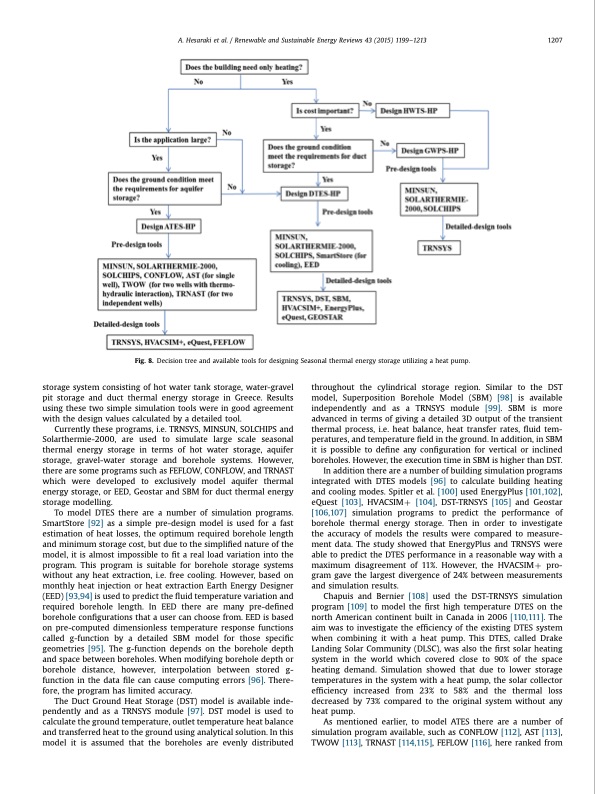
PDF Publication Title:
Text from PDF Page: 009
A. Hesaraki et al. / Renewable and Sustainable Energy Reviews 43 (2015) 1199–1213 1207 Fig. 8. Decision tree and available tools for designing Seasonal thermal energy storage utilizing a heat pump. storage system consisting of hot water tank storage, water-gravel pit storage and duct thermal energy storage in Greece. Results using these two simple simulation tools were in good agreement with the design values calculated by a detailed tool. Currently these programs, i.e. TRNSYS, MINSUN, SOLCHIPS and Solarthermie-2000, are used to simulate large scale seasonal thermal energy storage in terms of hot water storage, aquifer storage, gravel-water storage and borehole systems. However, there are some programs such as FEFLOW, CONFLOW, and TRNAST which were developed to exclusively model aquifer thermal energy storage, or EED, Geostar and SBM for duct thermal energy storage modelling. To model DTES there are a number of simulation programs. SmartStore [92] as a simple pre-design model is used for a fast estimation of heat losses, the optimum required borehole length and minimum storage cost, but due to the simplified nature of the model, it is almost impossible to fit a real load variation into the program. This program is suitable for borehole storage systems without any heat extraction, i.e. free cooling. However, based on monthly heat injection or heat extraction Earth Energy Designer (EED) [93,94] is used to predict the fluid temperature variation and required borehole length. In EED there are many pre-defined borehole configurations that a user can choose from. EED is based on pre-computed dimensionless temperature response functions called g-function by a detailed SBM model for those specific geometries [95]. The g-function depends on the borehole depth and space between boreholes. When modifying borehole depth or borehole distance, however, interpolation between stored g- function in the data file can cause computing errors [96]. There- fore, the program has limited accuracy. The Duct Ground Heat Storage (DST) model is available inde- pendently and as a TRNSYS module [97]. DST model is used to calculate the ground temperature, outlet temperature heat balance and transferred heat to the ground using analytical solution. In this model it is assumed that the boreholes are evenly distributed throughout the cylindrical storage region. Similar to the DST model, Superposition Borehole Model (SBM) [98] is available independently and as a TRNSYS module [99]. SBM is more advanced in terms of giving a detailed 3D output of the transient thermal process, i.e. heat balance, heat transfer rates, fluid tem- peratures, and temperature field in the ground. In addition, in SBM it is possible to define any configuration for vertical or inclined boreholes. However, the execution time in SBM is higher than DST. In addition there are a number of building simulation programs integrated with DTES models [96] to calculate building heating and cooling modes. Spitler et al. [100] used EnergyPlus [101,102], eQuest [103], HVACSIMþ [104], DST-TRNSYS [105] and Geostar [106,107] simulation programs to predict the performance of borehole thermal energy storage. Then in order to investigate the accuracy of models the results were compared to measure- ment data. The study showed that EnergyPlus and TRNSYS were able to predict the DTES performance in a reasonable way with a maximum disagreement of 11%. However, the HVACSIMþ pro- gram gave the largest divergence of 24% between measurements and simulation results. Chapuis and Bernier [108] used the DST-TRNSYS simulation program [109] to model the first high temperature DTES on the north American continent built in Canada in 2006 [110,111]. The aim was to investigate the efficiency of the existing DTES system when combining it with a heat pump. This DTES, called Drake Landing Solar Community (DLSC), was also the first solar heating system in the world which covered close to 90% of the space heating demand. Simulation showed that due to lower storage temperatures in the system with a heat pump, the solar collector efficiency increased from 23% to 58% and the thermal loss decreased by 73% compared to the original system without any heat pump. As mentioned earlier, to model ATES there are a number of simulation program available, such as CONFLOW [112], AST [113], TWOW [113], TRNAST [114,115], FEFLOW [116], here ranked fromPDF Image | Renewable and Sustainable Energy Reviews 43

PDF Search Title:
Renewable and Sustainable Energy Reviews 43Original File Name Searched:
tes-heat-pumps.pdfDIY PDF Search: Google It | Yahoo | Bing
Turbine and System Plans CAD CAM: Special for this month, any plans are $10,000 for complete Cad/Cam blueprints. License is for one build. Try before you buy a production license. More Info
Waste Heat Power Technology: Organic Rankine Cycle uses waste heat to make electricity, shaft horsepower and cooling. More Info
All Turbine and System Products: Infinity Turbine ORD systems, turbine generator sets, build plans and more to use your waste heat from 30C to 100C. More Info
CO2 Phase Change Demonstrator: CO2 goes supercritical at 30 C. This is a experimental platform which you can use to demonstrate phase change with low heat. Includes integration area for small CO2 turbine, static generator, and more. This can also be used for a GTL Gas to Liquids experimental platform. More Info
Introducing the Infinity Turbine Products Infinity Turbine develops and builds systems for making power from waste heat. It also is working on innovative strategies for storing, making, and deploying energy. More Info
Need Strategy? Use our Consulting and analyst services Infinity Turbine LLC is pleased to announce its consulting and analyst services. We have worked in the renewable energy industry as a researcher, developing sales and markets, along with may inventions and innovations. More Info
Made in USA with Global Energy Millennial Web Engine These pages were made with the Global Energy Web PDF Engine using Filemaker (Claris) software.
Sand Battery Sand and Paraffin for TES Thermo Energy Storage More Info
| CONTACT TEL: 608-238-6001 Email: greg@infinityturbine.com | RSS | AMP |